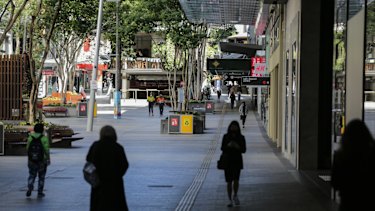Air quality levels can predict whether lockdowns have worked
The amount of a particular gas in the air over a region locked down to prevent the spread of COVID-19 gives an indication about whether the lockdown has worked, research suggests.
A global team of air-quality scientists has discovered that measuring the levels of nitrogen dioxide in the atmosphere above a locked-down region can give an accurate picture of how many people have been moving around.

The research found levels of nitrogen dioxide in the air over locked-down areas give a clear indication of how much economic activity has been taking place.Credit:Matt Dennien
Nitrogen dioxide is emitted from a range of sources, from industrial businesses to agriculture, as well as from the burning of fossil fuels in cars and industry.
One of the lead researchers, QUT Distinguished Professor Lidia Morawska, said they chose nitrogen dioxide because it was easy to track and was emitted by a large number of different activities.
“We look at it as a key indicator of economic activity during a lockdown, because the less people moving around, the less economic activity,†Professor Morawska said.
“The less economic activity, the less nitrogen dioxide in the air.â€

QUT air-quality expert Distinguished Professor Lidia Morawska.Credit:QUT
Professor Morawska said she and her colleagues looked at satellite imaging data from the start of the pandemic until January this year, and found a link between lower levels of nitrogen dioxide and successful lockdowns in most of the 211 territories studied for the research, including Australia.
On the other hand, areas that had higher levels of the gas following lockdown were more likely to endure another one shortly afterwards.
They claimed that if governments had used their modelling to make decisions about when to lift lockdowns, almost 1 million daily COVID-19 cases could have been avoided in the last northern winter.
The researchers found the effect “dampened†over time, and further reductions of nitrogen dioxide levels were associated with weaker reductions in the overall number of virus cases in a given region.
In Australia, Victoria had to go back into lockdown recently after seeming to get on top of its outbreak of the highly transmissible Delta variant of COVID, while Brisbane has lifted restrictions.
Sydney, meanwhile, has struggled to get on top of its current spate of cases, with the NSW government criticised for not locking down hard enough at the beginning of the outbreak.
The outbreaks now affecting Australian cities are outside the scope of the research, but there were some Australian examples used to form the modelling which was developed, while much of the data came from examples in China and the United States.
Nitrogen dioxide can be monitored in real-time by satellite at resolutions down to 50 kilometres, Professor Morawska said, meaning governments could use the measure as a tool in the future to help determine when to lift lockdowns.
“Once we understand this relationship [between levels of the gas and economic activity] we could say during the next outbreak that this lockdown needs to be longer, because based on our modelling, the decrease in economic activity has not been enough,†she said.
“Satellite data is available to governments in real-time, so they could look at the concentrations of nitrogen dioxide, look at the cases and in real-time make a decision about whether to lift a lockdown.â€
The research has been published in the journal Proceedings of the National Academy of Sciences.
Stuart Layt covers health, science and technology for the Brisbane Times.
0 Response to "Air quality levels can predict whether lockdowns have worked"
Post a Comment